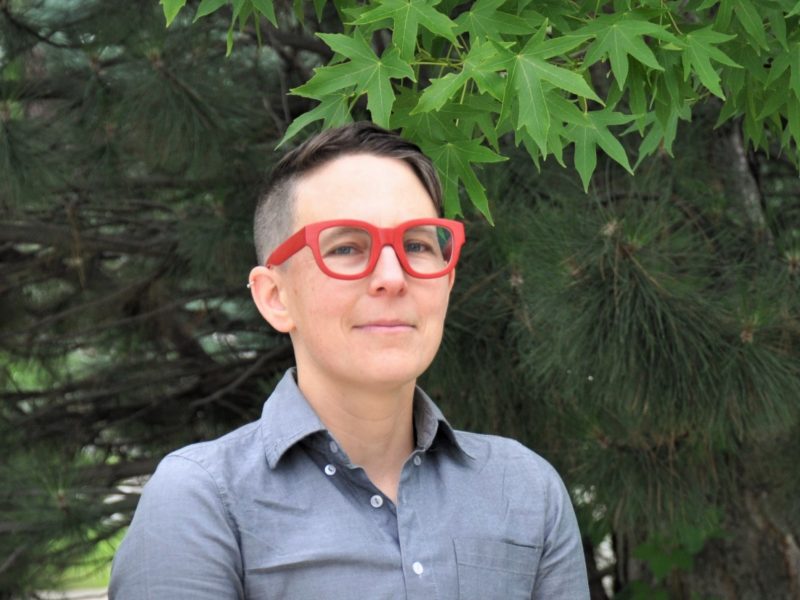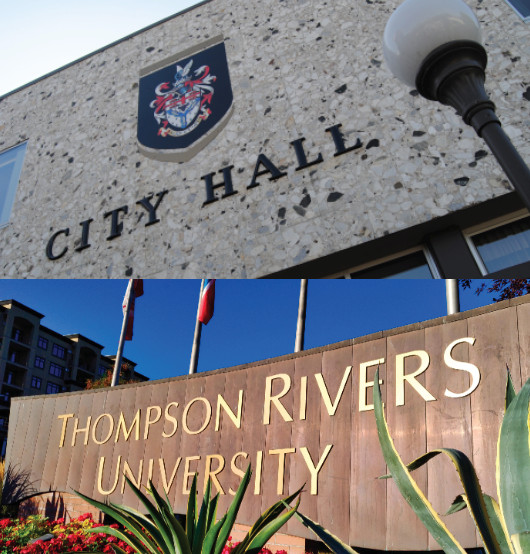
The Researcher-in-Residence (RiR) program, a three-year pilot project initiative between the City of Kamloops and Thompson Rivers University (TRU), has been getting a lot of attention, receiving two honourable mention awards even before its completion in 2024.
“There continue to be opportunities for TRU faculty and students to apply their expertise on city initiatives through a community-engaged research model, supporting staff and council as they develop changes to city policies and bylaws as well as new services and programs,” says Dr. Cheryl Gladu, lead researcher on the project. “So it’s impressive that we’re only halfway done and the program is already being recognized by two national, non-profit organizations.”

Photo courtesy of Kamloops this Week
Community Based Research Canada, a national champion and facilitator of community-based research excellence, nominated the RiR program for the 2022 Community Campus Research Partnership Award, receiving an honourable mention at the June 1 awards gala. The program was also awarded an honorable mention in the 2022 Canadian Association of University Business Officers (CAUBO) Quality and Productivity Awards Program at the CAUBO annual conference on June 13. CAUBO represents senior administrators at 106 Canadian universities and affiliated colleges and 38 community colleges.
Community-engaged research
The principal RiR team includes Gladu, five student interns and senior administrative staff from both the City and TRU’s Office of the Vice-President Research. Together they focus on particular city-led research areas each year, while also facilitating collaboration between faculty and students on campus, demonstrating how different approaches to research can create pathways for positive change in the city.
“When looking at housing in Kamloops in our first year of the program, we started collecting some data to round out information that was already here at the city, and in the process we were able to update and validate that information,” says Gladu. “And then once we started to see the gaps in that information, we started to do some searching on that, doing a lot of data collection and mapping of data, looking for new and effective ways to share information.”
Gladu adds that researchers are employing a two-pronged approach to continue the conversation on housing.
“One of our master’s students has chosen to do her thesis on measuring ‘the missing middle,’ which is a variety of housing typologies between single family homes and apartment blocks. She’s going to measure the demand for that in Kamloops, which is a wonderful addition to the research we’ve been doing around housing. I’m also joining a team of researchers with the Interior Universities Research Coalition of British Columbia, where we’re doing a study on homelessness — a systems mapping of the various players who intersect with issues around homelessness. I’ll be working with a few faculty members on campus with that, and we’re going to be comparing notes and sharing processes with folks at UBC Okanagan and the University of Northern BC.”
In the second year of the program, the RiR team is working with the city to collect information using cultural mapping to help with the development of the official Cultural Strategic Plan.
“We’re working with Kamloops Museum and Archives curator Matt Macintosh and museum supervisor Julia Cyr, who are going to be doing a public exhibition where folks can come in and do some cultural mapping, sharing ideas on where culture is in Kamloops and where it might not be,” says Gladu. “We’re working closely with the Office of Student Research and Public Engagement at TRU on that project, getting students to help us out. The idea is to increase citizen participation, allowing more people to contribute their experience and imagination to the project of imagining the future of culture in Kamloops.”
She and her colleagues are looking for an approach to make the RiR sustainable beyond the initial three years of funding.
“There’s a lot of good will in making it sustainable. On the whole, we’ve been able to meet expectations and the city’s quite happy with the work so far and happy with the potential of the work. There’s a lot of relationship building that has taken place in the first year and a half that probably won’t show fruit for a little while,” she says.

City of Kamloops External Relations Manager Tammy Robertson
“We are finding with all of this incredible data and analysis that’s happening on a variety of subjects, the largest one being on the housing continuum, we can make evidenced-based decisions, which would not be as fulsome without the Researcher-in-Residence initiative,” says Tammy Robertson, external relations manager at the City of Kamloops. “We have the longevity of this initiative to allow us to continue to gather data, analyze it, shift where new needs are and then take action. There’s a huge amount of value in that. And while all this incredible information is coming forward, many different departments and individuals in the city are using that important information to inform their work, their presentations and their recommendations to city council who enact policy.”
Unique program
When considering what makes this RiR program unique, support and active participation from TRU’s Office of Student Research and Public Engagement and the City of Kamloops tops the list.
“Because I’m in residence with the City of Kamloops, I meet with executives, directors and managers and get invited into meetings where they let me participate and listen to their challenges, which is unique,” says Gladu.
“I’m also not always meeting with the same person, with the same cluster of problems, so it’s not uncommon for researchers to have long-term relationships with community partners. This role puts me in the position of being like a vector for other possible streams of research for my campus-based colleagues, and that’s an exciting opportunity. I’m starting to see connections between not only disciplines on campus but also departments at the city. For example, cultural planning doesn’t only affect the cultural sector; it can also affect municipal planning from a buildings perspective as we consider how to address gaps in the cultural landscape. To see the crossover between faculty and departmental blind spots is important for me as an emerging scholar.
“And to have such a pan-university champion for community-engaged research in the Office of the VP Research at TRU is apparently very novel and fortunate, especially when applied research in the community may become a strategic advantage for universities, as we seek to address a growing crisis of relevance.”
As the interim Vice-President of Research Will Garrett-Petts explains, “The RiR initiative grew out of TRU’s Strategic Priorities Planning process and our university’s commitment to becoming the leading university in Canada for community-engaged research and student research training. So, it’s not an isolated partnership initiative, but rather a university priority and part of university-wide commitment. As Dr. Gladu notes, positioning RiR in this manner distinguishes our research partnership model from city-university partnerships developed elsewhere.”
The influx of student researchers to the program is another attribute of the program.
“Forty-four students have come into the program via work study placements, practicum placements and curricular placements,” says Gladu. “So that’s a lot more students than I was anticipating. But they get a really neat lens into the functioning of the city in a way I think is really important not only for them but for all of us. For example, nursing, social work and business students get to have a much deeper understanding of the complexity of the problems the city faces. By virtue of having a whole semester or longer, the students get to tackle one piece of a project and talk about what they’re learning, regularly. And we get to see their eyes open up in a new way around democracy, civics and the real entrenched nature of complex systems problems.”
“This program is exemplary not only for its unique partnership between a municipality and university but also for providing students with high impact research opportunities,” says Sukh Heer Matonovich, director, Student Research and Public Engagement.
“Embedding community engaged-research opportunities for students through curricular and co-curricular experiences provides students an opportunity to apply their disciplinary thinking to real issues in our community which is a distinguishing factor of this program.”
“We have this massive opportunity to look at our problems and work with students, staff and Cheryl to come up with information that is helping us deliver services to our citizens,” says Robertson. “The immersion of the city and TRU through this partnership, how the data is so readily available and how it’s informing decisions in a real-time way, is exceptional and unique. I want to give the visionaries a lot of credit for working hard to make this initiative a reality. The visionaries led to the concept, that led to commitment, that led to outstanding opportunities and outcomes.”
The partnership is generously supported by the City of Kamloops, Mitacs, the Social Sciences and Humanities Research Council of Canada, TRU’s Office of the Vice-President Research and the TRU Community Trust.
To find out more about the Researcher-in-Residence Program, watch this video.
 Stanley Cup Playoff etiquette
Stanley Cup Playoff etiquette A sea can is not a shed
A sea can is not a shed Sentencing finally set
Sentencing finally set Senators reject field trip
Senators reject field trip 'City within a city'
'City within a city' Searching landfill for woman
Searching landfill for woman Israeli strike played down
Israeli strike played down Full Trump jury seated
Full Trump jury seated World's largest election
World's largest election  Lululemon cuts 100 jobs
Lululemon cuts 100 jobs Bitcoin's 'halving' arrives
Bitcoin's 'halving' arrives Lawsuit over missing nuts
Lawsuit over missing nuts Warriors ready for Round 2
Warriors ready for Round 2 Kalamalka Bowl cancelled
Kalamalka Bowl cancelled Rockets live to fight on
Rockets live to fight on Pulp Fiction turns 30
Pulp Fiction turns 30 Chris Pratt injured in movie
Chris Pratt injured in movie My name is not Elaine
My name is not Elaine




